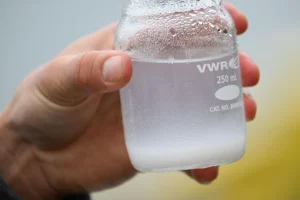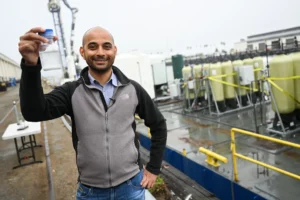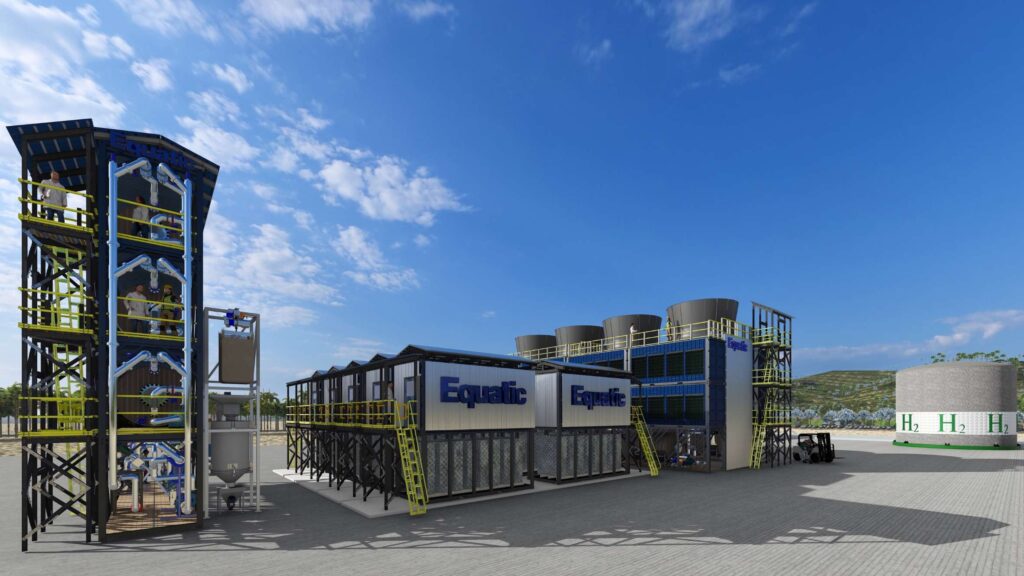Turning Air and Seawater into Clean Energy
In West Singapore, a startup is building a big plant by the ocean. It will change air and seawater into a material like seashells. This process will also make “green” hydrogen, a clean fuel.
The plant in Tuas will be the biggest ocean-based carbon dioxide removal plant. It’s made by Equatic, a startup from the University of California at Los Angeles.
Here’s how it works: the plant takes water from the ocean. Then, it uses electricity and air to trap and store carbon dioxide as minerals. These minerals can go back into the sea or be used on land.
Harnessing the Ocean’s Power
In the face of a worsening climate crisis, scientists are seeking solutions. Efforts to reduce global heating are falling short. To tackle this, we need to not only cut down on fossil fuels but also remove carbon already in the air.
One solution is happening in Singapore: a plant is capturing carbon from the air. Other projects are looking to the oceans, which absorb a lot of our pollution.
For example, some are adding iron to the ocean to help plankton absorb CO2. Others are sinking seaweed to trap carbon deep underwater. And some are spraying particles into clouds to reflect sunlight.
These projects offer hope for fighting climate change by using the power of the ocean.
Jean-Pierre Gatusso, an ocean scientist at Sorbonne University in France, says there are big knowledge gaps about ocean geoengineering. He worries that science isn’t keeping up with the industry.
How Equatic’s Technology Works
Equatic’s technology, tested in LA and Singapore, needs seawater, rocks, and electricity. First, seawater is pumped in. Then, electricity separates it into four parts: two liquids (acidic and alkaline) and two gases (hydrogen and oxygen).
Acidic water mixes with crushed rocks, adjusting pH like seawater, then returns to the ocean. Fans push air through the alkaline stream, causing carbon dioxide to turn into calcium carbonate, similar to seashells. This forms fine sand and dissolved bicarbonate.

Equatic is making a plant to help the environment. They’re using minerals to lock up carbon. This aids in the reduction of carbon dioxide in the atmosphere.
Gaurav Sant, a founder, says they do everything on land. They can measure everything they do. The plant will use $20 million to start. It will remove 3,650 metric tons of carbon dioxide yearly. This is like taking 870 cars off the road.
They want to remove even more CO2 in the future. Edward Sanders, the chief operating officer, says they can expand the plant. They hope to remove millions of metric tons of CO2. They can build more plants like this one. They want to help the environment everywhere.

“As the plant gets bigger, they need to make sure it doesn’t cause problems,” Sant explained. The outcome varies significantly depending on whether you use a small amount or a large amount. You have to check, keep an eye on things, and change as needed.
The initial investment is significant, but the company intends to generate revenue by selling carbon credits to polluters to assist in managing their pollution. They’ll also sell the hydrogen they make.
Equatic already has a deal with Boeing. They’re selling 2,100 metric tons of hydrogen to Boeing, which will be used to make eco-friendly fuel and help remove 62,000 metric tons of CO2.
Concerns About Ocean Carbon Removal
Some people worry about using new technology to fix climate change. Lili Fuhr thinks it might hurt the oceans more than help. She says it’s risky because climate change is already harming our oceans. Processing lots of seawater could kill marine animals.
Fuhr says power plants already do this. Equatic would process even more seawater than power plants. Thousands of these plants would be needed to make a real difference.
James Niffenegger, a researcher, says we need to watch closely. Moving water around like this on a big scale will be a huge task. It might mess up the ocean’s chemistry.
Niffenegger says we know about ocean acidification, but not much about making it more alkaline. He thinks the impacts might be small, but we won’t know until we try it.

Equatic’s Carbon Removal Project: A Controversial Solution
Equatic aims to remove carbon from the atmosphere by pulling it out of seawater. Some experts worry about its energy needs. They think clean energy should be used to replace fossil fuels instead.
Equatic claims it filters seawater to protect marine life. They say the discharged water will be the same as normal seawater. It will meet Singapore’s environmental rules.
The company says making hydrogen for power makes its method more energy-efficient.
Equatic’s project sparks debate. Some fear it could harm ecosystems. Others say it’s necessary due to the climate crisis.
UCLA’s Sant believes we must act quickly despite uncertainty. He insists that doing nothing is not a viable approach to addressing climate change.
Conclusion
To fight climate change, we must be willing to act fast, even with uncertain outcomes.
Also Read: E. coli Found in Ground Beef: USDA Official Alerts

